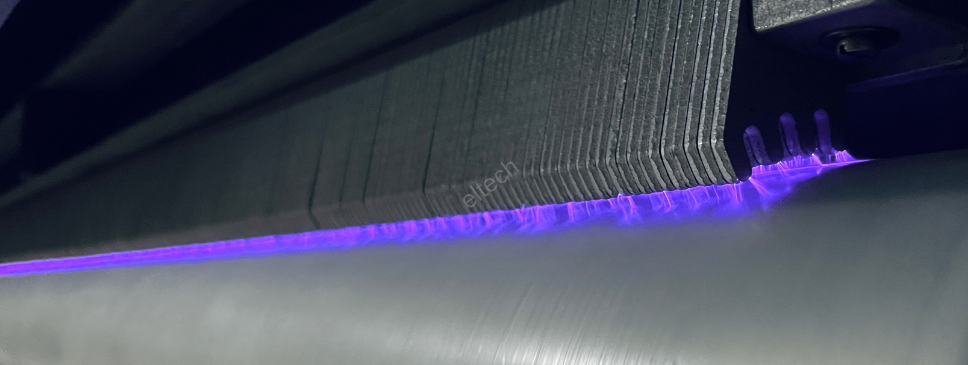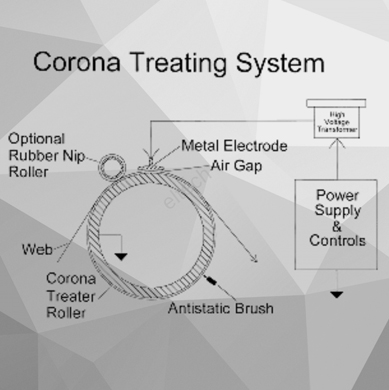Corona Treater System Manufacturers
- Home
- Corona Treater Systems
- Corona Treater System
What is a Corona Treater?

This is how a Corona Treater looks
A corona treating system is designed to increase the surface energy of plastic films, foils and paper in order to allow improved wettability and adhesion of inks, coatings and adhesives. As a result, the materials treated will demonstrate improved printing and coating quality, and stronger lamination strength. Corona treatment system increases the surface tension of the fabrics respective to inks by inducing molecular changes in the surface of the films. This is done by exposing the air at the material's surface to a high-voltage electrical discharge - a corona. Corona discharge treatment at atmospheric pressure for improving adhesion of various polymer substrates is now standard practice.
In the presence of a high voltage discharge in an air gap, free electrons, which are always present in the air, accelerate and ionise the gas. When the electric discharge is very strong, collisions of high velocity electrons with molecules of gas result in no loss in momentum, and electron avalanching occurs. When a plastic part is placed in the discharge path, the electrons generated in the discharge impact the surface with energies 2 to 3 times that necessary to break the molecular bonds on the surface of most substrates. This creates very reactive free radicals. These free radicals in the presence of oxygen can react rapidly to form various chemical functional groups on the substrate surface. Functional groups resulting from this oxidation reaction are the most effective at increasing surface energy and enhancing chemical bonding to the resin matrix. Surface treatment with high voltage discharge modifies only the surface characteristics without affecting material bulk properties.
A corona treating system consists of 4 major components: The Corona treater station, Corona Treater Panel , Ozone Extraction Blower & High Voltage Transformer.
What is Necessity of Surface Treatment?
Treating works best when a substrate is treated at the time of extrusion and in-line prior to converting. Pretreated films, that is films that have been surface treated at the time they were produced, exhibit a higher surface energy that is crucial to producing quality printed, coated or laminated products. Film that is not treated at the time of production will not accept printing, coating or lamination well. The opposite is not always true. Even if film is treated at the time of production, it will not always guarantee that printing, coating or laminating will be easily accomplished at any future time.
What is Theory of Corona Treatment?

Corona Treating System
The surface tension of plastic films is not sufficiently high to permit good adhesion of print ink with plastic film. In the case of lamination, it prevents better bonding between two or more materials. Hence, for better quality printing, lamination, and coating processes, the surface tension of the plastic films should be increased. The Corona Treatment method is widely used nowadays to increase the surface tension of the films.The Corona Treatment of plastic film is done by passing the film through the corona discharge created between electrode and dielectric covered (Usually Silicone Rubber Sleeve) earthed roller as shown in the figure. The air gap between electrode & roller is 2-2.5 mm. The electrode is connected to an electrical supply having high voltage & high frequency. As the film passes through the corona discharge, molecules of the surface get oxidized which has more surface tension. The corona discharge between electrode and roller is visible by violet color flame between them.
Corona Treater Systems
- Inside Surface Treatment of container with Ozone
- Corona Treater on Continuous PUF Panels
- Corona Treater for Extrusion Coating Plant
- Corona Treater for Lamination Film Plant
- Corona Treater for Monolayer Film Plant
- Corona Treater for Multilayer Film Plant
- Corona Treater for Woven Sacks Printing Machine
- Corona Treater for Batch Printing Machine
- Corona Treater for Label Flexo Printing
- Corona Treater for Dry Offset Printing Machine
- Corona Treater for Metalized Film Plant
- Corona Treater for PP Flute Board
- Corona Treater for Round Bottles
- Sheet Corona Treater

